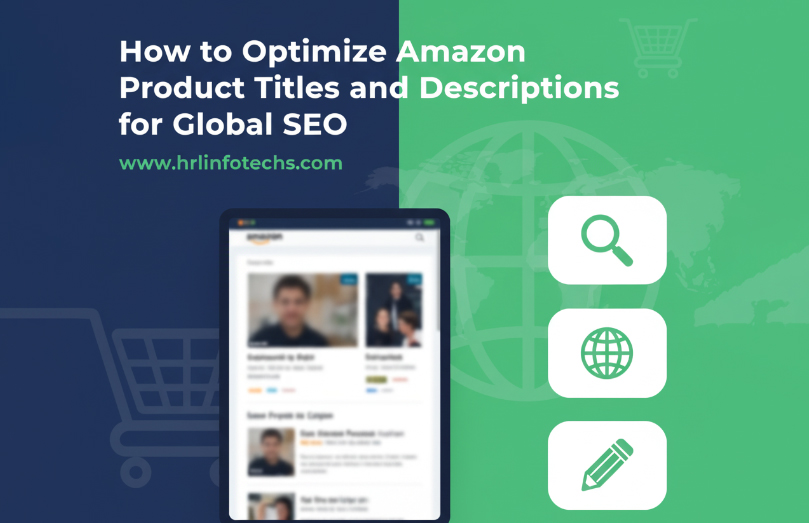Expanding Amazon’s business worldwide is thrilling, yet getting lost in the crowd is easy. Good products are not enough; you must have listings directly addressing buyers. Optimizing product titles and descriptions to sound international can increase visibility and sales. In this guide, we will take a step-by-step tour of tips that can be used to maximize Amazon product listings and be successful internationally.
1. Why Amazon SEO Matters for International Markets
Going globally with a business is not about translating listings. It is about understanding buyers’ search and shopping patterns in the respective countries. Amazon’s global market SEO ensures that people see the right products. For example, in the US, people search for sneakers, whereas in the UK, people search for trainers.
It is worth researching the local keywords and search habits. Give each market what it desires. A slight change of wording may increase visibility and sales significantly.
2. Crafting Product Titles That Actually Convert
The product title is the first impression; therefore, make it count. Amazon’s best practices do not require using keywords in large quantities; they need clarity, conciseness, and helpfulness. The best way to think of it is to tell the buyer, “Here is what you are getting.”
Also, when applicable, include the brand, product type, prominent feature, and size or quantity. For example, replace ‘Wireless Headphones Bluetooth Noise-Canceler Black’ with SoundMax Wireless Noise-Canceler Headphones—Bluetooth, Black, Over-Ear Comfort. The wording is natural when discussing essential details.
3. Using Keywords Effectively
Keywords connect what the buyer types with what a product provides. Amazon optimization includes inserting keywords into titles, bullet points, and product descriptions.
Look beyond obvious terms. Long-tail keywords, such as “durable travel backpack for hiking,” are more convertible since they have a specific intention. Search using the keyword applications and consult Amazon’s search suggestions. The keywords that buyers do not know they need are sometimes the best.
4. Writing Product Descriptions That Feel Human
A product description should be helpful for conversation, not a textbook. The best strategies in Amazon listings emphasize benefits rather than features.
Rather than “This jacket is water-resistant,” write, “Stay dry on a rainy day with this water-resistant jacket—it works just as well when you are travelling or going to work.” Use short paragraphs, bullet points, and easy-to-read headings to make it quick for the buyers to scan.
5. The Power of Bullet Points
Bullet points also enable you to highlight certain significant benefits without overburdening the reader. One clear idea should be expressed in every point. This is where the Amazon optimization tips work out.
Focus on features that matter to buyers. For example, instead of saying “Made of stainless steel,” say “Durable stainless steel construction ensures mug lasts for years, even with daily use.” Adding small practical details like this can build trust and encourage purchases.
6. Don’t Ignore Backend Search Terms
Backend search terms are often overlooked but can significantly improve Amazon’s product page optimization. These keywords aren’t visible to buyers but help Amazon match a product with relevant searches.
Include synonyms, abbreviations, and related terms that might not fit naturally in the visible content. For instance, if selling a yoga mat, consider terms like “exercise mat,” “workout mat,” or “fitness mat.” This ensures the product reaches a broader audience without cluttering the listing.
7. Localizing Listings for Each Market
Selling globally is more than translation—it’s localization. Amazon SEO for international markets means adjusting language, units, and cultural references.
For example, if the product is a measuring cup, include both cups and milliliters, depending on the region. Also, certain adjectives or benefits resonate differently—”eco-friendly” might matter more in Germany, while “durable” could sell better in the US. A little attention to these details makes the listing feel personal and thoughtful.
8. Optimizing Images and Multimedia
Good visuals aren’t optional—they’re essential. High-quality images, lifestyle photos, and videos help buyers understand the product better and boost conversions.
Include multiple angles, close-ups of essential features, and images showing the used product. Videos demonstrating setup or usage can reduce customer confusion, lower returns, and improve keyword ranking. Visuals and descriptions together create a complete shopping experience that feels trustworthy.
9. Monitor, Test, and Adapt
Even after implementing Amazon listing SEO techniques, the work isn’t done. Track clicks, conversions, and keyword performance for each market. Test variations of titles, bullet points, and images to see what resonates.
Selling globally is about learning and adapting. What works in one market may not work in another. Minor adjustments over time—like tweaking a headline or changing the order of bullet points—can significantly improve results. Continuous optimization is the key to staying ahead of the competition.
Conclusion:
Optimizing Amazon product listings for global markets is about more than algorithms—it’s about connecting with people. Use clear, descriptive titles, engaging bullet points, and descriptions that answer real buyer questions. Combine this with well-chosen keywords, localized content, and strong visuals, giving the products the best chance to succeed internationally.
Selling globally doesn’t have to be complicated. Start small, focus on the details, and keep testing. Each tweak brings the product listings closer to perfection. By following these Amazon listing optimization tips and strategies, you’re improving visibility, building trust, and increasing conversions. Ultimately, product listings should feel helpful, trustworthy, and easy to buy from—just like a human would naturally want.





